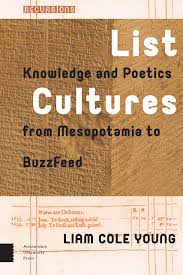In List Cultures: Knowledge and Poetics from Mesopotamia to Buzzfeed, Liam Cole Young places our current obsession with the list in historical context, tracing their emergence, myriad uses and changing significance. While its use of theory may be occasionally dense for the more general reader, this book is a fascinating study that succeeds in shedding light on our seeming love of the list today, writes Marion Koob.
List Cultures: Knowledge and Poetics from Mesopotamia to BuzzFeed. Liam Cole Young. Amsterdam University Press. 2017.
Write this review
Do the laundry
Print out travel tickets for tomorrow
This is my to-do list for a grey December Sunday.
It is undeniable: in these digital times, we have fallen in love with the list. Few things are more delightful than perusing a listicle; we turn to itemising our actions when we are feeling overwhelmed in the form of the above beloved to-do list; and our cultural markers emerge in rankings of top tens and hundreds. It is hard not to see lists everywhere.
This makes List Cultures: Knowledge and Poetics from Mesopotamia to BuzzFeed a timely study of the form. Rooted in media theory, the book offers an analysis of lists, our relationship with them and what their prevalence means for our way of thinking. Liam Cole Young uses a diverse collection of case studies to illustrate his argument. We are shown that lists lie at the heart of the modern music industry (think of the ‘Top 50’ charts published every week by the likes of Billboard); told about their emergence in Ancient Mesopotamia; and of their extensive use by the Nazi regime. Finally, we move to their glorification in our ever-connected world.
From a theoretical perspective, Young argues for the greater prominence of media materialism, and particularly the civilisational approach of the Toronto School, which broadly states that the form of a communication system creates particular societal and psychological dispositions. He bridges this and German media studies and their shared multidisciplinary approach. Tying the two together, he argues, creates an avenue to extend the field in new ways. He also states that non-narrative forms of writing, including lists but also other types of administrative records, are understudied. To look at them closely is to reveal new insights about how our societies functioned and still do today.
 Image Credit: (freestocks.org CCO)
Image Credit: (freestocks.org CCO)
Two chapters speak particularly to these arguments. In Chapter Four, ‘The Nazi Census and Making Up People’, Young shows that the administrative bent of this regime was an expression of logistical modernity. In a previous chapter, Young traces the origin of logistical modernity to fifteenth-century Italian merchants and the creation of double-entry bookkeeping. This type of record demonstrated a new way of viewing the world: that of a place filled with materials which needed to be calculated, compressed and circulated.
The Nazi state took on this logic of logistical modernity, inherited down the centuries, and gave it a nefarious form. Calculation, compression and circulation now pertained not only to material goods, but also to people. The whole German population was totalled in records. Once accounted for, their data was divided according to notions of productive potential and, horrifyingly, of ‘foreignness’ and ‘other’. Through this documentation, the regime formed a base of information which bore the appearance of fact upon which it could then choose to act. The list of ‘others’ was calculated and compressed onto sheets of paper. The existence of these records allowed the individuals they identified to be ‘circulated’ in the physical world. In other words, once this list of ‘others’ was established, it enabled the regime to exercise control over the individuals it named and, subsequently, forcibly transport them to ghettoes or concentration camps.
Young elaborates this argument through outlining a history of the Hollerith punch cards, a technology provided by the then-emergent IBM that proved essential to the administrative system. He also references the modern obsession with statistics – a method which gives a veneer of legitimacy to whatever material it touches. He also remarks on how notions of ‘productivity’ and ‘optimisation’ were adapted in chilling ways by the Nazi regime and implemented in their policies, as expressed in lists and forms: ‘According to Nazi ideology […] a healthy population […] was also one that operated at a maximum productive capacity. Human labour and vitality in undesirable […] elements of the Volk were not simply discarded, but were mobilized until their productive power was used up. This programme worked Jews to death’ (99).
This chapter makes for compelling reading and is doubtlessly one of the best of the book. Here, Young stays true to his interdisciplinary approach. He brings in strands of economics and history to support his arguments, and their benefit shows. This section’s only – and minor – flaw is that it appears to veer away from the book’s purported theme, shifting focus from lists to the whole system of administration. But the arguments are interesting enough for this to be easy to overlook.
Young’s study subsequently turns to the present day in Chapter Five, ‘Logistics: Listicles, Algorithms and Real Time’. Here the author states that the same logistical bent extends to our present time, starting with the listicle: ‘within the BuzzFeed platform are operational lists geared towards data mining and computational processes that employ the same techniques of compression, calculation, and circulation’ (107). The author goes on to describe a dizzying process whereby BuzzFeed listicles themselves make for a source of data collection about their readers. This information is then funnelled back into the company’s proprietary software to generate more viral content, more clicks and more marketing revenue. The whole website itself is one long, continuously updating list of the trending content on the platform.
The listicle is only the most recent iteration of logistical modernity, Young concludes, one that ‘reduces people and things to a standing reserve of data to be collected, compiled and analysed’ (122). Lists no longer exists in space, whether on a page or in the double-entry books of fifteenth-century merchants. Instead, they reside in time, in databases ‘that are constantly made and remade according to the ever-accelerating feedback loop of input/output’ (125). This chapter, an under-the-hood perspective on our current cultural proclivities, gives time for pause.
Young argues that there is solace, however, from this ever-present logistical modernity. Artists, writers and philosophers such as Jorge Luis Borges, Walter Benjamin and Chris Marker have subverted the list by using its form in non-orthodox and provocative ways. The first catalogues the absurdity of the quotidian; the second uses lists as ‘ruins of possibility never realized’; the third seeks to list ‘things that quicken the heart’. In other words, lists here ‘provoke thought, grief and wonder’ (143). Young argues that these figures therefore reveal the hidden mode of thinking implied in the use of a list: i.e. that it biases us towards the logistical. This argument makes for a poetic conclusion to an otherwise analytical read.
List Cultures is a fascinating overview. Young deftly links different theoretical approaches and leans on various disciplines to support his reasoning. At times, he gets lost in the former, and it is hard to tease out a clear line of argument in Chapter Two and Chapter Six. As such, List Cultures is best destined for academic readers in the field of media studies as the book wades deep in theoretical debates. While its thoughtful conclusions are pertinent to all and bring our current obsessions into new light, non-expert readers will have to work hard to get to them.
This review originally appeared at the LSE Review of Books.
Please read our comments policy before commenting.
Note: This article gives the views of the authors, and not the position of USAPP– American Politics and Policy, nor of the London School of Economics.
Shortened URL for this post: http://bit.ly/2zotdui
——————————————–
About the reviewer
Marion Koob
Marion Koob is a freelance features writer. She has a BSc in Government and Economics from the LSE, and an MPhil in International Relations from the University of Cambridge. Previously, she has worked in Polis – the LSE’s journalism think-tank – and the British Film Institute. Read more by Marion Koob.


 Find this book:
Find this book: 

